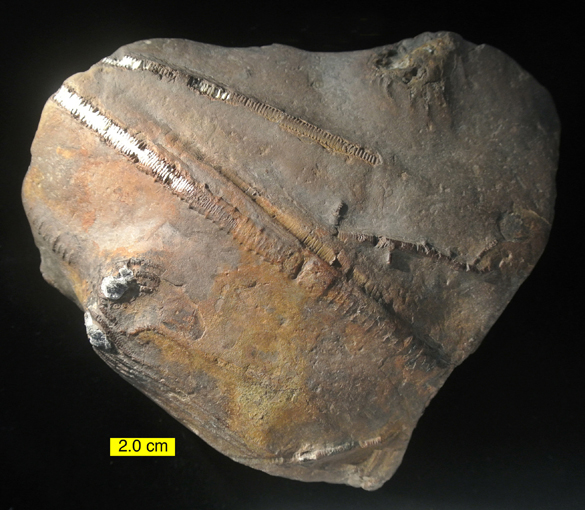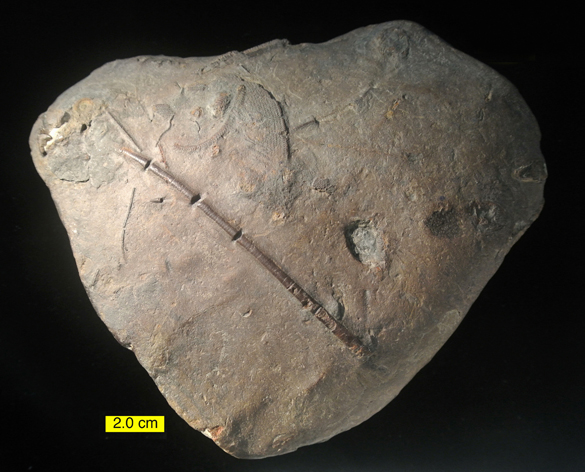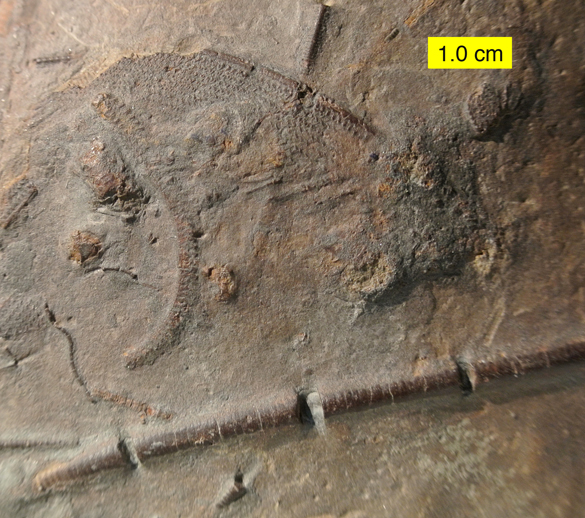 Last year Wooster emeritus geology professor Sam Root generously donated the above pictured siderite concretion to our paleontology collections. He had received it from a friend who didn’t know where it came from originally so we have no location. The fossils in it, though, show it is Lower Carboniferous in age and could well be from local outcrops of the Cuyahoga Formation. Sam knew this is a cool specimen so he wanted to see what we could make of it.
Last year Wooster emeritus geology professor Sam Root generously donated the above pictured siderite concretion to our paleontology collections. He had received it from a friend who didn’t know where it came from originally so we have no location. The fossils in it, though, show it is Lower Carboniferous in age and could well be from local outcrops of the Cuyahoga Formation. Sam knew this is a cool specimen so he wanted to see what we could make of it.
In the top view we can see crinoid stems running transversely across the surface. Remarkably, two crinoid calices (the arm-bearing crown of the crinoid at the top of the stem) are visible. The larger one is in the lower left. You can see the top of the stem to the farthest left, and then the calyx and attached arms to the right. The second calyx is in the upper right with the arms extending down and towards us. Finding one crinoid calyx with the delicate arms still attached is impressive; finding two in the same slab is a real treat.
 Above is the other side of the concretion. Again a crinoid stem can be seen transverse across the surface. This stem is different from those on the other side, though. It does not have external sculpture, and it is separated into distinct pluricolumnals as if someone sawed through it at regular intervals.
Above is the other side of the concretion. Again a crinoid stem can be seen transverse across the surface. This stem is different from those on the other side, though. It does not have external sculpture, and it is separated into distinct pluricolumnals as if someone sawed through it at regular intervals.
 A closer view of the above shows yet another crinoid calyx, this one almost entirely buried in the rock with the arms extending to the surface. The arms have smaller sub-arms (pinnules) still attached. Amazing.
A closer view of the above shows yet another crinoid calyx, this one almost entirely buried in the rock with the arms extending to the surface. The arms have smaller sub-arms (pinnules) still attached. Amazing.
The concretion is made of the mineral siderite (an iron carbonate) that precipitated in fine-grained sediments around the fossils after they were buried. This usually takes place under subsurface anoxic and slightly acidic conditions. The crinoids with all their small and easily-disarticulated parts were buried quickly on the ancient seafloor, probably by a storm-induced pulse of silts and clays. The decay of their soft parts produced hydrogen sulfide gas ad carbon dioxide, triggering the geochemistry that caused the precipitation of siderite around them. The hard concretion that resulted was likely in a matrix of soft shale. The strength of the siderite kept the fossils from being crushed by the weight of sediment above. At some point many millions of years later, the shale eroded away and the concretion was freed to be picked up by some lucky person.
The crinoid stem that is divided into regular increments is interesting on its own. These segments with multiple columnals (the poker chip-like individual elements) are called pluricolumnals. They likely broke at pre-set weaknesses in the connective tissue of the living crinoid, something we see in their living descendants. This may have allowed them to break off their stems (autotomize) when in danger so that the calyx and remaining stem could float away for re-establishment elsewhere.
This concretion is so interesting that I (forgive me, Sam) could not resist cutting it open to see what is inside. The inner view is even more fascinating and will be revealed next week in part II of this story. As a teaser, it involves four minerals and a surprising mollusk!
References:
Baumiller, T.K. and Ausich, W.I. 1992. The broken-stick model as a null hypothesis for crinoid stalk taphonomy and as a guide to the distribution of connective tissue in fossils. Paleobiology 18: 288-298.
Gautier, D.L. 1982. Siderite concretions; indicators of early diagenesis in the Gammon Shale (Cretaceous). Journal of Sedimentary Research 52: 859-871.



Thought you might like this. I first saw this (or something similar) video several years ago:
http://palaeo-electronica.org/2007_1/crinoid/fig3.htm
And… for the bio enthusiasts, here also is the link to the Encyclopedia of Life (EOL) website link for Neocrinus decorus:
http://eol.org/pages/4708319/details
I’ve been looking for that spooky video for years, Bill. Thank you very much. Now it is permanently linked in the blog. And you’ll notice I put those italics in for you! (I’m always happy when someone knows they’re required.) Hope all is well!
I live in Orrville and have some fossils I found in Wayne County I would love for someone to look at. Please let me know if you would be willing to, and thank you.
Hi Sherry: I’d love to see your fossils. Since I’m on leave I’m not in my office, but you can send photos to my email address: mwilson@wooster.edu .